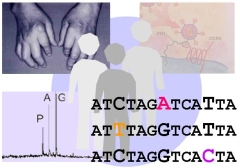
Analysis of the genetics of complex biological traits with Pattern Recognition
 Most traits of an organism are of a complex nature and result from the interaction of several genes and environmental factors. These
polygenic phenotypes are contrasted by monogenic phenotypes which are largely defined by a single gene.
Most traits of an organism are of a complex nature and result from the interaction of several genes and environmental factors. These
polygenic phenotypes are contrasted by monogenic phenotypes which are largely defined by a single gene.
In any given human population, most genes are present in several variants (genotypes). As a result, the individuals of these population will
exhibit different variants (phenotypes) of a given trait. Examples are the color of hair, eyes, and skin, the shape of earlobes and the
functioning of blood coagulation factors. Some, especially monogenic, traits show only a small number of distinct phenotypes. Other traits,
which are usually polygenic, are expressed in a continuum of phenotypes and are caused by genes in so called quantitative trait loci
(QTLs).
The inheritance of monogenic traits follows Mendels laws and can easily be followed in family trees. Gene loci for monogenic traits are
relatively easily identified in so called genome scans if the underlying gene variants are of high penetrance.
The inheritance of complex traits is based on genome wide variant patterns (GVPs, a collection of variants of different genes) rather than
variants of a single gene. Each of the genetic variants in a GVP usually contributes only slightly to the complex traits (low penetrance).
Therefore, the inheritance of complex traits does not appear to follow Mendels laws. In genome scans, candidate regions for gene loci of
complex traits may be identified. However, these are usually rather large, containing many genes. Some identified loci may be false positive
while others may not be detected at all.
Our approach for identifying the genes underlying complex traits is to select candidate genes based on various sources of information.
These include genome scans, analyses of the literature, and whole genome association scans. We are especially interested in diseases
with complex etiology and pathogenesis, in particular rheumatoid arthritis. In our studies, we are attempting to define the phenotype (here
presence of disease) as specifically as possible. The accumulated data include laboratory results, questionnaires, x-ray data and more.
After genotyping of polymorphisms in selected candidate genes in patients and healthy controls, PATTERN EXPERT anySNP provides an opportunity
to search for GVPs correlating with the disease with help of pattern recognition methods.
This work is carried out in collaboration with the groups of Dr. Peter Ahnert from University of Leipzig and Dr. Karla Koepke Charite Berlin.

